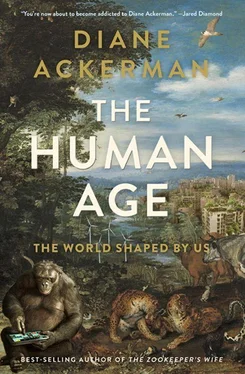In Antarctica, where the average coastal temperature is -70°F with inland dips to -180°F, the American research base, McMurdo Station, is a town of naked machines and heavily insulated people. There darkness saturates winter, inking out the sky for six months, during which occasional green auroras shoot up like magnetic demons’ tails, and indoors the auroras are falling white showers of man-made fluorescence. There are two primary smells (sweat and diesel fuel) and two primary colors (black and white). Fresh produce arrives by air from Los Angeles and costs $80,000 to $100,000 per week in the summer. During the winter, deliveries may be months apart.
“Clearly, this is no banana belt,” says Robert Taylor, the good-humored technician who, along with many volunteers, has overseen McMurdo’s 649-square-foot greenhouse. “And there is no history of oxen tied to wooden plows turning over rich black soil. Actually, on this side of the continent, there is no soil at all, only weathered volcanic rock and, of course, ice. There is nothing in the way of organic matter to speak of, and no recognizable terrestrial plants. And yet, life blooms… under thousands of watts of artificial light.”
It’s hardly roomy, especially compared to gardens in his hometown of Missoula, Montana. But by using hydroponic techniques he’s been able to harvest about 3,600 pounds of spinach, Swiss chard, cucumbers, herbs, tomatoes, peppers, and other vegetables each year—pure manna to the green-starved residents.
“Not enough to register on the world’s export market, but nothing to sneer at if you are one of the approximately 200 people who choose to winter here,” Taylor says via e-mail.
“Lettuces grow like champs,” he notes. “There are nearly 900 lettuce heads growing at any time on tiered growing systems. Likewise, basil and parsley are herbs that need very little in the way of input.” That’s just as well, because he has to pollinate them all by hand, since insects, the natural pollinators, are forbidden, lest they devastate the small greenhouse Eden.
“It’s strange that a horticulturist would come all the way to Antarctica to grow vegetables, but as far as challenges and thrills, what better place to confront the beauty of plants than in an environment so devoid of them?… Each tomato, each cucumber becomes a jewel, precious.”
As if it were a laid-back bar in Key West, two hammocks and a cozy old armchair float in a humid corner, “for those who wish to commune with arugula.” Many do. At McMurdo, not only vegetation but humidity, scent, and natural colors are rare. On the other hand, howling isolation and intense relationships are the norm. Many people thrive on the parabolic sunlight and unusually intimate community. But those beset by “polar T3,” overwintering syndrome, can find their thyroid levels askew and metabolism rocky, with sleeplessness, irritation, and depression constant bedfellows. In an all-white kingdom of ice and snow, where the only low-hanging fruit are the stars, one’s sanity can tremble on a stem slender as a marigold’s.
Fortunately, purple-and-yellow pansies and orange marigolds (both edible) grow in the greenhouse, where the rainbow stalks of Swiss chard create a small psychedelic forest, and scarlet cherry tomatoes dangle from string supports like floppy marionettes. Cilantro, basil, chives, rosemary, and thyme scent the air. The sensory repast as well as the food nourishes greenhouse visitors, and the plants lap up the CO 2exhaled by the humans. Unlike typical greenhouses in winter, this one has no sunlight streaming through cathedral-like walls of glass. McMurdo’s urban farm at the bottom of the world is completely sealed and insulated, and, in a stark village where windows are precious, I’m told it also offers a leafy idyll for a dinner date. Even in this extreme outpost of a city, the benefits of greening ease the way.
There will soon come a time when farming needn’t have a country flavor, and referring to “the north forty” means crops forty floors up. PlantLab in the Netherlands grows forty different crops indoors, using hydroponics and high-tech sensors, without pesticides, and even without windows. Plants don’t need the whole spectrum of light; instead each crop is raised with the precise amount of blue or red light it craves. As the water evaporates, it’s recycled, so only a pittance extra is needed. In these specially controlled environments, the crop yield is three times higher than outdoors, and the process would do equally well in the Sahara or Siberia once LED lights become a bit cheaper.
All of our buildings need to earn their keep. We’re probably in the last era of deadbeat buildings. In the United States alone, buildings use 40 percent of the country’s raw materials, burn 65 percent of the total electricity, and drain 12 percent of drinkable water, while piling up 136 million tons a year of demolition and construction wastes.
SUPPOSE THE GOAL is buildings that are inherently living organisms. Just how alive could a home or office become? In addition to living walls and planted roofs, its skin could mimic plant metabolism and animal musculature. “Biomimicry” is an old idea but a dynamic and lucrative new direction in architecture and engineering that mines the genius of nature to find sustainable solutions to knotty human problems.
Picture: Houses painted with lotusin, a self-cleaning paint inspired by the water-shedding veneer of leaves. Products colored without pigments, echoing the way light dances across peacock and blue-jay feathers. New lenses and fiber optics that mimic the almost distortion-free lenses coating the body of a brittle sea star, or the flexible optics atop a sea sponge’s tentacles. Electronic devices inspired by mussel tissue, which automatically dissolve when you discard them. A building whose outer skin resembles the porelike stomata of leaves and provides all the energy it needs. Ships’ hulls engineered like whale skin to glide through the water while burning less fuel, and airplane wings that save fuel by mimicking ripple-edged whale fins.
The result is organic, self-assembling, nonpolluting solutions that nature has already mastered and we can copy. This frame of mind requires a major flip in our way of thinking and our sense of how we exist in nature. For the longest time, “heat, beat, and treat” was the industrial motto. We’ve built cities and fueled empires by raiding the Earth’s resources, chopping them up, heating them, breaking them down with toxic chemicals, and fastening them together. Biomimicry asks: “Okay, that’s how humans make things—and it doesn’t work. How does life make things?”
“Organisms have figured out ways to do the miraculous things they do,” the biomimicry pioneer Janine Benyus says, “without jeopardizing the future of their resources and offspring.”
Inspired by Benyus and others, cities are blooming with architecture that functions like (and sometimes resembles) growing organisms. Imagine transparent skyscrapers that save energy as their facades expand and contract like an elaborate array of muscles. In a working prototype designed by the New York firm Decker Yeadon, swirling silver ribbons in the glass facade are really a three-layered muscle: a rubbery polymer sheathing a flexible polymer core, with a silver coating that skittles an electrical charge across the surface. If it’s too cold, the ribbon-muscles “fire” and contract to slender squiggles, exposing lots of window to the sun. In hot weather, the ribbons expand like a patchwork of shot silk to create a flat parasol of shade. Many small segments self-regulate in this way, fiddling with their own thermostat to stay in homeostasis. Much as we do. Too warm? Shed the sweater and move out of the direct sun. As a design, muscular walls are more flexible and stronger than solar panels.
Читать дальше












